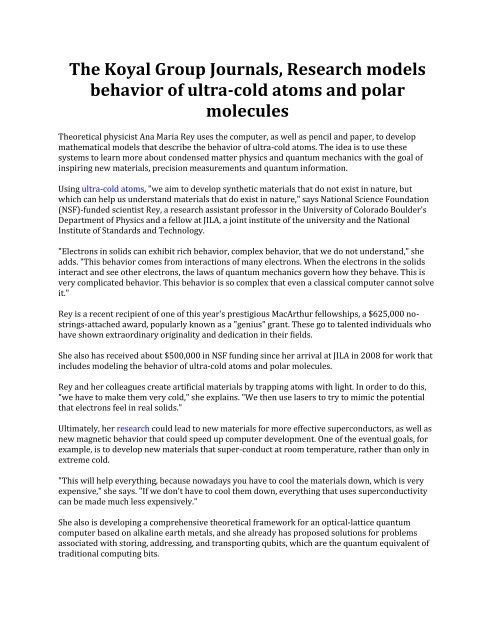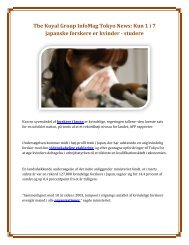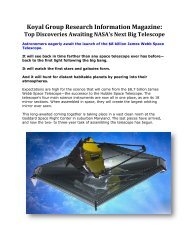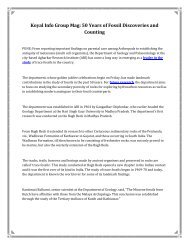Create successful ePaper yourself
Turn your PDF publications into a flip-book with our unique Google optimized e-Paper software.
<strong>The</strong> <strong>Koyal</strong> <strong>Group</strong> <strong>Journals</strong>, <strong>Research</strong> <strong>models</strong><br />
<strong>behavior</strong> <strong>of</strong> <strong>ultra</strong>-<strong>cold</strong> <strong>atoms</strong> <strong>and</strong> <strong>polar</strong><br />
<strong>molecules</strong><br />
<strong>The</strong>oretical physicist Ana Maria Rey uses the computer, as well as pencil <strong>and</strong> paper, to develop<br />
mathematical <strong>models</strong> that describe the <strong>behavior</strong> <strong>of</strong> <strong>ultra</strong>-<strong>cold</strong> <strong>atoms</strong>. <strong>The</strong> idea is to use these<br />
systems to learn more about condensed matter physics <strong>and</strong> quantum mechanics with the goal <strong>of</strong><br />
inspiring new materials, precision measurements <strong>and</strong> quantum information.<br />
Using <strong>ultra</strong>-<strong>cold</strong> <strong>atoms</strong>, "we aim to develop synthetic materials that do not exist in nature, but<br />
which can help us underst<strong>and</strong> materials that do exist in nature," says National Science Foundation<br />
(NSF)-funded scientist Rey, a research assistant pr<strong>of</strong>essor in the University <strong>of</strong> Colorado Boulder's<br />
Department <strong>of</strong> Physics <strong>and</strong> a fellow at JILA, a joint institute <strong>of</strong> the university <strong>and</strong> the National<br />
Institute <strong>of</strong> St<strong>and</strong>ards <strong>and</strong> Technology.<br />
"Electrons in solids can exhibit rich <strong>behavior</strong>, complex <strong>behavior</strong>, that we do not underst<strong>and</strong>," she<br />
adds. "This <strong>behavior</strong> comes from interactions <strong>of</strong> many electrons. When the electrons in the solids<br />
interact <strong>and</strong> see other electrons, the laws <strong>of</strong> quantum mechanics govern how they behave. This is<br />
very complicated <strong>behavior</strong>. This <strong>behavior</strong> is so complex that even a classical computer cannot solve<br />
it."<br />
Rey is a recent recipient <strong>of</strong> one <strong>of</strong> this year's prestigious MacArthur fellowships, a $625,000 nostrings-attached<br />
award, popularly known as a "genius" grant. <strong>The</strong>se go to talented individuals who<br />
have shown extraordinary originality <strong>and</strong> dedication in their fields.<br />
She also has received about $500,000 in NSF funding since her arrival at JILA in 2008 for work that<br />
includes modeling the <strong>behavior</strong> <strong>of</strong> <strong>ultra</strong>-<strong>cold</strong> <strong>atoms</strong> <strong>and</strong> <strong>polar</strong> <strong>molecules</strong>.<br />
Rey <strong>and</strong> her colleagues create artificial materials by trapping <strong>atoms</strong> with light. In order to do this,<br />
"we have to make them very <strong>cold</strong>," she explains. "We then use lasers to try to mimic the potential<br />
that electrons feel in real solids."<br />
Ultimately, her research could lead to new materials for more effective superconductors, as well as<br />
new magnetic <strong>behavior</strong> that could speed up computer development. One <strong>of</strong> the eventual goals, for<br />
example, is to develop new materials that super-conduct at room temperature, rather than only in<br />
extreme <strong>cold</strong>.<br />
"This will help everything, because nowadays you have to cool the materials down, which is very<br />
expensive," she says. "If we don't have to cool them down, everything that uses superconductivity<br />
can be made much less expensively."<br />
She also is developing a comprehensive theoretical framework for an optical-lattice quantum<br />
computer based on alkaline earth metals, <strong>and</strong> she already has proposed solutions for problems<br />
associated with storing, addressing, <strong>and</strong> transporting qubits, which are the quantum equivalent <strong>of</strong><br />
traditional computing bits.
Among other things, she is attempting to resolve long-st<strong>and</strong>ing obstacles to large-scale<br />
entanglement between <strong>atoms</strong>, which quantum computers require both for communication <strong>and</strong><br />
calculations.<br />
"We want to use <strong>atoms</strong> trapped in light to create a quantum computer," she says. "<strong>The</strong> internal<br />
levels <strong>of</strong> the atom are the qubits <strong>of</strong> the computer. For example, we are proposing <strong>atoms</strong> in the<br />
second column <strong>of</strong> the periodic table--alkaline Earth elements, such as strontium--which have large<br />
number <strong>of</strong> degrees <strong>of</strong> freedom to improve computation capabilities."<br />
Such research potentially could produce smaller <strong>and</strong> faster computers with capabilities that<br />
classical computers do not now have. "A classical computer has to do its computations one at a<br />
time, but with quantum mechanics, all the computations are done in parallel," she says.<br />
Finally, she also is working on advances in developing an optical atomic clock.<br />
"Atoms are a tool that allows us to measure time in a very precise way," she says. "<strong>The</strong> energy levels<br />
<strong>of</strong> an atom are like the ticking <strong>of</strong> a clock. <strong>The</strong> higher the energy separation between levels, the more<br />
ticks you have <strong>and</strong> the more precise your clock.<br />
"<strong>The</strong> atomic clock measures time, <strong>and</strong> to measure time better, we need more <strong>atoms</strong>," she says. "<strong>The</strong><br />
more <strong>atoms</strong> we have, the higher the signal-to-noise ratio, meaning that in principle, the clock is<br />
more precise."<br />
One persistent problem, however, is that atom collide, "<strong>and</strong> that is bad for the clock," she adds.<br />
"What I have done is try to underst<strong>and</strong> the origins <strong>of</strong> these collisions, <strong>and</strong> try to control them in<br />
order to improve the clock."<br />
-- Marlene Cimons, National Science Foundation<br />
Investigators<br />
Ana Rey<br />
Deborah Jin<br />
Chris Greene<br />
Eric Cornell<br />
Murray Holl<strong>and</strong><br />
Victor Gurarie<br />
William Lineberger<br />
Related Institutions/Organizations<br />
University <strong>of</strong> Colorado at Boulder





